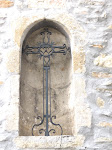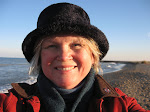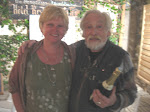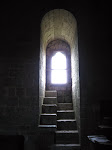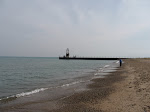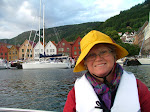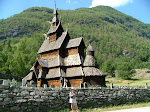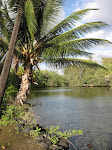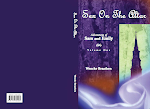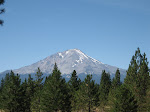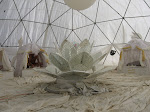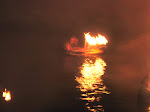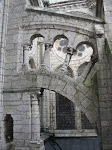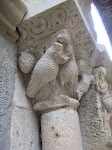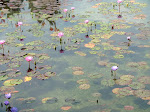I live in Chicago, and I walk along the lake nearly every day. Tonight, I met a flock of medical students who were grilling at Montrose Beach. They invited me to a piece of chicken, and we started talking. It quickly came out that I'm a writer.
When the cook heard what I was writing about, he called for his friend who studies theology and introduced me. These young people are eager to hear a new viewpoint. They have open ears for different information than what they have been fed. First they asked if I thought everything in "The Da Vinci Code" was true.
I admire Dan Brown for having started the discussions. The actual facts about Mary Magdalene and Jesus are few and far between. Very little passes our tough criteria for being given the approval stamp of "truth". (Curiously, many things in our history books are quite questionable, but have passed as true for years.) When it comes to what is "true" of the Biblical stories, there isn't really a whole lot to build a case on, for or against. There are many possibilities of what might be the truth. It depends on where you look for facts. It depends on what credence you give to stories told by different authors, who all claim their portion of truth. It depends of what depth you are looking for. There are many ways to build a story.
When I started writing "Rituals in Sacred Stone", I researched the time frame of Jesus and Mary Magdalene. What was happening politically? What religious beliefs and what mythology were in people's consciousness? What education were these two powerful people likely to have? From what schools? What background did they have that made them so respected?
What I found astonished me. The more I read, the more I researched and traveled, the bigger my peephole became, looking into their culture. I found a society brimming with life, with interactions with cultures from all over the known world, which was quite vast at their time. In year zero, the Roman Empire had been in function for several hundred years. Alexander the Great, before the Romans, had discovered India. Alexandria was the biggest city, the New York of their time, with commerce connecting them to the rest of the world. The only thing not included was America. They were aware of different religions, languages, philosophical ideas, and had studied architecture styles in detail. Food staples were shared across cultural lines, musical instruments influenced each other and people intermarried.
What surprised me the most, was their level of education and scholarship and how willingly they shared information between the different universities. There was a respect for knowledge as something valuable, as a body of knowing owned by a person.
The mystery schools were widespread. We know some of them now as archaeological sites of ancient times. Ephesus, the library of Alexandria and the pyramids are the first to come to mind. But there were many more, less famous sites, who were influential as great seats of learning.
The Druids had universities in Britain which were as influential as the library and temple complex in Alexandria. There was a city called Leontopolis north of Heliopolis with a temple dedicated to the cat goddess Bast. They had a festival every year, where all the other temple schools were invited. There was a Jewish temple near Heliopolis that taught the same things as the temple of Jerusalem. Great controversies arose between the two. An Egyptian Temple called Oppidum Priscum Ra existed on an island outside of Marseilles. The commercial routes made it easy for people to travel and exchange information. The Serapium in Alexandria focused on healing. Ephesus focused on oracles. Baia in southern Italy had a whole complex inside a mountain focused on advanced initiations. The temple to Isis in Languedoc, France, was studying the planet Venus and her movements. The Druids were expert astrologers. There was a flourishing of information and available education, to anyone who so desired and according to their ability and interest.
So why wouldn't Jesus and Mary Magdalene have been highly educated, widely respected scholars in their fields? There is no reason to believe otherwise.
I may not have "proof" of their level of education, but their stories certainly tell me that they knew far more than their peers. It would be disrespectful to believe that they hadn't been properly prepared for the momentous task they took on.
I shared this with the medical students, and their faces lit up. The holes in the stories of the Bible aren't empty. They are filled with knowledge and education that didn't fit the mold established in 425AD. I think young people want to know what the holes contain. And they're asking without judgement of the past, but with eager open hearts, sensing that there is a new body of knowledge condensing in front of them.
Wencke.
Saturday, May 31, 2008
Monday, May 26, 2008
She was a master gardener.
When I traveled in France last year, I'd researched my trip thoroughly before I left. I'd found the different stories I wanted to follow, I'd read up on the local legends pertending to her.
Still, hiking the hills she walked, visiting the holy places named after her and taking in the powerful scent of the landscape, is like walking in a dream that transcends time and allows you to pick a timeframe to relate through.
Trees are trees and plants are plants. The cedars are timeless. The broom plant with the honey smelling small yellow orchids on top probably were the same in her time. The lavender haven't changed, and they showed me the old way it was harvested at the Lavender Museum in Provence. The hills roll in pleasing curves, down right feminine in their expression. I've never thought a landscape can be romantic, but I found myself smiling for no reason and writing sweet entries in my journal, which surprised me later in their sincerity.
She was known for her perfumes. The cathedral in St.Maxime-de-la-baume is dedicated to her, and specifically for the holy balm she made. I read that the scent of the tuberose was her favorite. And when I investigated further I found that the ancient French word for tuberose was Maryam.
I found that there was a Roman Villa in the area, whith a famous herb farm run by priestesses from Egypt. The story practically wrote itself. So I wrote it down, the way it came to me.
My novel, "Rituals in Sacred Stone" will be out on Amazon this fall. I'll keep you posted.
Wencke.
Still, hiking the hills she walked, visiting the holy places named after her and taking in the powerful scent of the landscape, is like walking in a dream that transcends time and allows you to pick a timeframe to relate through.
Trees are trees and plants are plants. The cedars are timeless. The broom plant with the honey smelling small yellow orchids on top probably were the same in her time. The lavender haven't changed, and they showed me the old way it was harvested at the Lavender Museum in Provence. The hills roll in pleasing curves, down right feminine in their expression. I've never thought a landscape can be romantic, but I found myself smiling for no reason and writing sweet entries in my journal, which surprised me later in their sincerity.
She was known for her perfumes. The cathedral in St.Maxime-de-la-baume is dedicated to her, and specifically for the holy balm she made. I read that the scent of the tuberose was her favorite. And when I investigated further I found that the ancient French word for tuberose was Maryam.
I found that there was a Roman Villa in the area, whith a famous herb farm run by priestesses from Egypt. The story practically wrote itself. So I wrote it down, the way it came to me.
My novel, "Rituals in Sacred Stone" will be out on Amazon this fall. I'll keep you posted.
Wencke.
Wednesday, May 21, 2008
Emma Calve, the opera singer.
I just looked through the pictures I have from France last summer, and once again the beauty of the small church dedicated to Mary Magdalene in Rennes-le-Chateau overwhelmed me. Sauniere had some interesting ideas for church decorating when he renovated his church, to an astonishing sum of money. The colors inside this small space match with a Beatrice Potter children's book. The clear light blue, the color of a sweet summer day, go well with the soft peach and the lavish use of gold. There is a soft turquoise there as well. Where did he get his ideas? The colors would look lovely in a Parisian woman's boudoir. Did Emma Calve, the opera singer he knew, help him out?
Sauniere is always pictured in a black cassock, appearing very much the image of a devout priest. Still, he visited Emma in Paris frequently, and she and a flock of fine people came from Paris to his remote little mountain top in the Languedoc, more than a days train ride away, to enjoy fine dining and entertainment. The stories here are just begging to be written.
I recently visited Nashville, Tennessee, and learned that Emma Calve had been there performing an opera on the stage later known to us all as The Grand Old Opry. The area around Nashville was called the Mero district, after an early mayor of New Orleans who was related to the Merovingian kings of fifth century France. The same Merovingian family had their stronghold close to Rennes-le-Chateau. They claimed to be descendents of Christ and Mary Magdalene, and have divine rights to the throne. Was it their geneology Sauniere found inside a pillar? Another story that needs to be told.
I'm a story teller and a novel writer. This is where I play.
Wencke.
Sauniere is always pictured in a black cassock, appearing very much the image of a devout priest. Still, he visited Emma in Paris frequently, and she and a flock of fine people came from Paris to his remote little mountain top in the Languedoc, more than a days train ride away, to enjoy fine dining and entertainment. The stories here are just begging to be written.
I recently visited Nashville, Tennessee, and learned that Emma Calve had been there performing an opera on the stage later known to us all as The Grand Old Opry. The area around Nashville was called the Mero district, after an early mayor of New Orleans who was related to the Merovingian kings of fifth century France. The same Merovingian family had their stronghold close to Rennes-le-Chateau. They claimed to be descendents of Christ and Mary Magdalene, and have divine rights to the throne. Was it their geneology Sauniere found inside a pillar? Another story that needs to be told.
I'm a story teller and a novel writer. This is where I play.
Wencke.
Wednesday, May 14, 2008
What skull, or whose skull?
There was a time when skulls were popular. There was a time when the wisdom was thought to reside in the head, even after a persons death. There was a time when some people knew how to retrieve that information.
There are some severed heads which have made their mark in history. We know the story of the head of John the Baptist. What if he wasn't simply executed, but his head was thought of as a powerful political tool? What if the wife, Herodias, knew exactly what she was asking her daughter to request, and that it's revelation would ruin Herod's career?
What if the Knights Templar really had a head in their possession? What if they knew how to make it speak? What if the rituals reserved for their highest initiates contained knowledge inconceivable to us now?
The skull of Mary Magdalene is claimed to exist and is on display at her cathedral in St.Maxime-de-la-Baume, in the town dedicated to the holy balm in the alabaster jar. I have been there. It feels remarkably authentic.
I can't imagine anybody separating her head from the body, out of a grave. Maybe at the time of the relics, her body parts got distributed between the churches that claim to have a bone of her? It's just that, very few of them do. Except for this one in Provence, where her brother was bishop.
Was her head prepared to hold her wisdom for future generations to tap into? What did they do in Ephesus, where they worked with oracles? What is an oracle anyway?
As you can tell, I have more question than answers. But, at least, I'm willing to ask the questions.
Wencke.
There are some severed heads which have made their mark in history. We know the story of the head of John the Baptist. What if he wasn't simply executed, but his head was thought of as a powerful political tool? What if the wife, Herodias, knew exactly what she was asking her daughter to request, and that it's revelation would ruin Herod's career?
What if the Knights Templar really had a head in their possession? What if they knew how to make it speak? What if the rituals reserved for their highest initiates contained knowledge inconceivable to us now?
The skull of Mary Magdalene is claimed to exist and is on display at her cathedral in St.Maxime-de-la-Baume, in the town dedicated to the holy balm in the alabaster jar. I have been there. It feels remarkably authentic.
I can't imagine anybody separating her head from the body, out of a grave. Maybe at the time of the relics, her body parts got distributed between the churches that claim to have a bone of her? It's just that, very few of them do. Except for this one in Provence, where her brother was bishop.
Was her head prepared to hold her wisdom for future generations to tap into? What did they do in Ephesus, where they worked with oracles? What is an oracle anyway?
As you can tell, I have more question than answers. But, at least, I'm willing to ask the questions.
Wencke.
Saturday, May 10, 2008
The skull and the book.
Why are they always at her side? In all the churches dedicated to her in southern France, and their are many, we see these symbols. The more familiar alabaster jar is often present, and we also see her carrying a cross.
Why are there so many churches dedicated to her in this secluded part of the world? We don't find this in other countries. The local legends claim she was there. The boat that rescued her from the dangers of Jerusalem took her to her exile in beautiful Provence, and her travels took her through rustic Languedoc.
In my historical novel "Rituals in Sacred Stone", which will be available on Amazon this fall, I follow the legends of her life. The stories from her time and from these areas are rich. I don't claim truth, but I do claim a new interpretation.
What could her symbols mean? Did she share carrying the cross with him? Did she write a book? There are fragments of a gospel after her, which have just been researched and given an inspiring interpretation by Karen King. Or did he write a gospel, which was left in her care? The Cathars were known to have a sacred text from the Saviour himself. The church wanted to get hold of it, and the documents went underground. Did it find it's way to a grotto near Rennes-le-Chateau? Maybe the new movie will give some answers.
The skull, well, that's another story. I'll explore that in the next blog.
Wencke.
Why are there so many churches dedicated to her in this secluded part of the world? We don't find this in other countries. The local legends claim she was there. The boat that rescued her from the dangers of Jerusalem took her to her exile in beautiful Provence, and her travels took her through rustic Languedoc.
In my historical novel "Rituals in Sacred Stone", which will be available on Amazon this fall, I follow the legends of her life. The stories from her time and from these areas are rich. I don't claim truth, but I do claim a new interpretation.
What could her symbols mean? Did she share carrying the cross with him? Did she write a book? There are fragments of a gospel after her, which have just been researched and given an inspiring interpretation by Karen King. Or did he write a gospel, which was left in her care? The Cathars were known to have a sacred text from the Saviour himself. The church wanted to get hold of it, and the documents went underground. Did it find it's way to a grotto near Rennes-le-Chateau? Maybe the new movie will give some answers.
The skull, well, that's another story. I'll explore that in the next blog.
Wencke.
Friday, May 9, 2008
Bloodline, the movie. Hidden treasure in southern France.
I just read Joan Norton's review of the movie on her blog, Mary Magdalene Within. The movie is a documentary following a man's journey through the mysteries surrounding Rennes-le-Chateau, a tiny village on a mountaintop in southern France. He claims to have found a hidden underground chamber containing a corpse and several historic items.
This particular little mountaintop has been an important place in history since the Romans. The stories echoing among these hills have threads to all major movements for the last two thousand years. The hills and mountains are perforated with grottoes and ravines, underground rivers and caves, all covered in vegetation that is hard to penetrate.
On my trip to the area a year ago, I wanted to walk the hills, singing like Maria von Trapp, only to get myself entangled in brambles and brush. The vegetation, which looks very friendly from a distance, is so dense that even a good machete wouldn't do you much good. So these researchers must have hiked the mountainside for years, to stumble upon this find.
Rennes-le-Chateau is one of five mountains surrounding another hill jutting sharply up in the center of the landscape. La Pique is a narrow ridge, which is also hard to get to the top of, unless you follow the long path around it. The five mountains mark the five points of a pentagonal star, the footprint of the path of Venus, seen from the Earth. Legends say there was a temple dedicated to Venus on this ridge, built long before the Romans. The priests of the temple knew how to communicate with Venus, using the surrounding landscape to gather energy and information. If a vortex is created by the movement of the planet, and it points down to a specific spot on the earth, there were technicians of old who knew how to work with the energy generated.
The Romans wanted to know how, but never got hold of the knowledge. The Catholic church, which in effect is an extension of the Roman Empire, never got hold of it either. But in the attempts to shield knowledge, important items were hidden away. And the caves and grottoes of the area gave them ample opportunities to do so.
What treasures are we talking about? The presence of Mary Magdalene is apparent in local legends. More obscure legends says that the Lord was buried in the area. Newer stories talks about the Knights Templar and the treasure they brought from Jerusalem. The Jewish settlement in Narbonne knew all about their activities. Did the Prince of Narbonne supply them with information about the Temple Mount, the basement of King Salomon's Temple? Did he send them out to rescue important artifacts that otherwise would have fallen in wrong hands? The tales say the "things" the Templars brought back went through the Languedoc area on their way to Paris. Were some very secret and very important items hidden securely in a forgotten valley? How about the Visigoths who also inhabited these hills and forests? Or the Celts? They all had treasure that was mentioned in documents. These objects are not accounted for any longer. But in several places it is hinted, that they might be buried between five mountain tops in the Languedoc.
I look forward to see the movie when it comes to Chicago. If someone was looking for treasure or hidden items, the landscape south of Carcassonne around Rennes-le-Chateau holds enough secrets to satisfy even Indiana Jones.
Wencke.
This particular little mountaintop has been an important place in history since the Romans. The stories echoing among these hills have threads to all major movements for the last two thousand years. The hills and mountains are perforated with grottoes and ravines, underground rivers and caves, all covered in vegetation that is hard to penetrate.
On my trip to the area a year ago, I wanted to walk the hills, singing like Maria von Trapp, only to get myself entangled in brambles and brush. The vegetation, which looks very friendly from a distance, is so dense that even a good machete wouldn't do you much good. So these researchers must have hiked the mountainside for years, to stumble upon this find.
Rennes-le-Chateau is one of five mountains surrounding another hill jutting sharply up in the center of the landscape. La Pique is a narrow ridge, which is also hard to get to the top of, unless you follow the long path around it. The five mountains mark the five points of a pentagonal star, the footprint of the path of Venus, seen from the Earth. Legends say there was a temple dedicated to Venus on this ridge, built long before the Romans. The priests of the temple knew how to communicate with Venus, using the surrounding landscape to gather energy and information. If a vortex is created by the movement of the planet, and it points down to a specific spot on the earth, there were technicians of old who knew how to work with the energy generated.
The Romans wanted to know how, but never got hold of the knowledge. The Catholic church, which in effect is an extension of the Roman Empire, never got hold of it either. But in the attempts to shield knowledge, important items were hidden away. And the caves and grottoes of the area gave them ample opportunities to do so.
What treasures are we talking about? The presence of Mary Magdalene is apparent in local legends. More obscure legends says that the Lord was buried in the area. Newer stories talks about the Knights Templar and the treasure they brought from Jerusalem. The Jewish settlement in Narbonne knew all about their activities. Did the Prince of Narbonne supply them with information about the Temple Mount, the basement of King Salomon's Temple? Did he send them out to rescue important artifacts that otherwise would have fallen in wrong hands? The tales say the "things" the Templars brought back went through the Languedoc area on their way to Paris. Were some very secret and very important items hidden securely in a forgotten valley? How about the Visigoths who also inhabited these hills and forests? Or the Celts? They all had treasure that was mentioned in documents. These objects are not accounted for any longer. But in several places it is hinted, that they might be buried between five mountain tops in the Languedoc.
I look forward to see the movie when it comes to Chicago. If someone was looking for treasure or hidden items, the landscape south of Carcassonne around Rennes-le-Chateau holds enough secrets to satisfy even Indiana Jones.
Wencke.
Her message, what was it? Who was she?
Her message, what was it? Who was she?
Will we ever know? Where can we search?
The buzz started with The Da Vinci Code, goes on. Bloodline, the movie is coming soon, what will it tell us?
I've been asking these questions for a long time. I've been searching for information for decades. In recent years, the shelves in the bookstores have given me books to dive into, great research to investigate, new interpretations to explore. There is a new attitude out there about her. People are looking for information beyond the established, approved sources.
And there is information to be found. We know more about her time, the customs and traditions she was part of. We know a lot more about the political climate she lived in. And we're starting to see the faint light from the mystery schools that existed in her time, which she must have been familiar with. Like beacons from light houses, they are inviting us in, asking us to participate, to explore.
In this space, I invite you to join me on this journey of discovery.
Peace,
Wencke.
Will we ever know? Where can we search?
The buzz started with The Da Vinci Code, goes on. Bloodline, the movie is coming soon, what will it tell us?
I've been asking these questions for a long time. I've been searching for information for decades. In recent years, the shelves in the bookstores have given me books to dive into, great research to investigate, new interpretations to explore. There is a new attitude out there about her. People are looking for information beyond the established, approved sources.
And there is information to be found. We know more about her time, the customs and traditions she was part of. We know a lot more about the political climate she lived in. And we're starting to see the faint light from the mystery schools that existed in her time, which she must have been familiar with. Like beacons from light houses, they are inviting us in, asking us to participate, to explore.
In this space, I invite you to join me on this journey of discovery.
Peace,
Wencke.
Subscribe to:
Comments (Atom)



